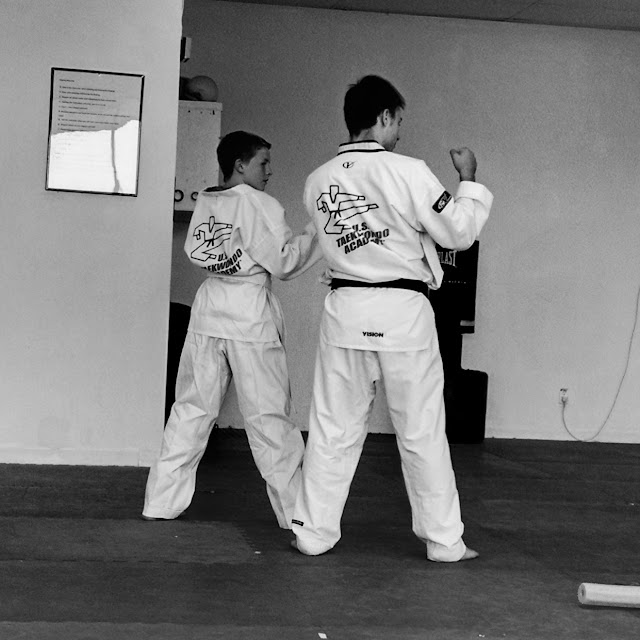Hunter and Jameson kick it in Taekwondo
- Ye-Ui, courtesy
- Yom-Chi, integrity
- In-Nae, perseverance, patience
- Guk-Gi, self-discipline
- Beakjul-bool-gul, invincibility of spirit
Taekwondo (English pronunciation /ˌtaɪˌkwɒnˈdoʊ/ or /ˌteɪˌkwɒnˈdoʊ/ or (thai-KWAN-doh): Korean 태권도 (hangul) / 跆拳道 (hanja)[tʰɛk͈wʌndo]), also transcribed as Taekwon-Do or Tae Kwon Do) is a Korean martial art with a heavy emphasis on kicks. Taekwondo was developed during the 1940s and 1950s by various Korean martial artists, as a blend of the indigenous Korean fighting styles oftaekkyeon, gwonbeop, and subak, with influence from foreign martial arts, such as Karate and Chinese martial arts.
The oldest governing body for Taekwondo is the Korea Taekwondo Association (KTA) which was formed in 1959 by a collaborate effort by representatives from the nine original kwans, or martial arts schools, in Korea. The main international organizational bodies for Taekwondo today are the International Taekwon-Do Federation (ITF), founded by General Choi Hong Hi in 1966, and the World TaeKwonDo Federation (WTF), founded in 1973 by the KTA. Gyeorugi ([kjʌɾuɡi]), a type of sparring, has been an Olympic eventsince 1992. The body known for Taekwondo in the Olympics is the World Taekwondo Federation.
- Reaction Force - the principle that as the striking limb is brought forward, other parts of the body should be brought backward in order to provide more power to the striking limb. As an example, if the right leg is brought forward in a roundhouse kick, the right arm is brought backward to provide the reaction force.
- Concentration - the principle of bringing as many muscles as possible to bear on a strike, concentrating the area of impact into as small an area as possible.
- Equilibrium - maintaining a correct center-of-balance throughout a technique.
- Breath Control - the idea that during a strike one should exhale, with the exhalation concluding at the moment of impact.
- Mass - the principle of bringing as much of the body to bear on a strike as possible; again using the turning kick as an example, the idea would be to rotate the hip as well as the leg during the kick in order to take advantage of the hip's additional mass in terms of providing power to the kick.
- Speed - as previously noted, the speed of execution of a technique in taekwondo is deemed to be even more important than mass in terms of providing power.












Comments
Post a Comment